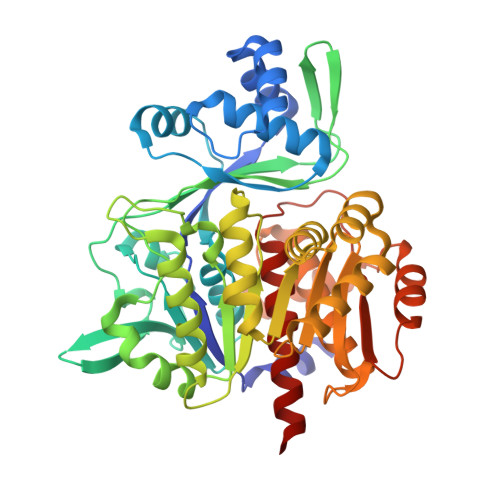Crystal structure of ADP-dependent glucokinase from Methanocaldococcus jannaschii in complex with 5-iodotubercidin reveals phosphoryl transfer mechanism.
Tokarz, P., Wisniewska, M., Kaminski, M.M., Dubin, G., Grudnik, P.(2018) Protein Sci 27: 790-797
- PubMed: 29352744
- DOI: https://doi.org/10.1002/pro.3377
- Primary Citation of Related Structures:
5OD2 - PubMed Abstract:
ADP-dependent glucokinase (ADPGK) is an alternative novel glucose phosphorylating enzyme in a modified glycolysis pathway of hyperthermophilic Archaea. In contrast to classical ATP-dependent hexokinases, ADPGK utilizes ADP as a phosphoryl group donor. Here, we present a crystal structure of archaeal ADPGK from Methanocaldococcus jannaschii in complex with an inhibitor, 5-iodotubercidin, d-glucose, inorganic phosphate, and a magnesium ion. Detailed analysis of the architecture of the active site allowed for confirmation of the previously proposed phosphorylation mechanism and the crucial role of the invariant arginine residue (Arg197). The crystal structure shows how the phosphate ion, while mimicking a β-phosphate group, is positioned in the proximity of the glucose moiety by arginine and the magnesium ion, thus providing novel insights into the mechanism of catalysis. In addition, we demonstrate that 5-iodotubercidin inhibits human ADPGK-dependent T cell activation-induced reactive oxygen species (ROS) release and downstream gene expression, and as such it may serve as a model compound for further screening for hADPGK-specific inhibitors.
- Faculty of Biochemistry, Biophysics and Biotechnology, Jagiellonian University in Krakow, ul. Gronostajowa 7, Krakow, 30-387, Poland.
Organizational Affiliation:




















